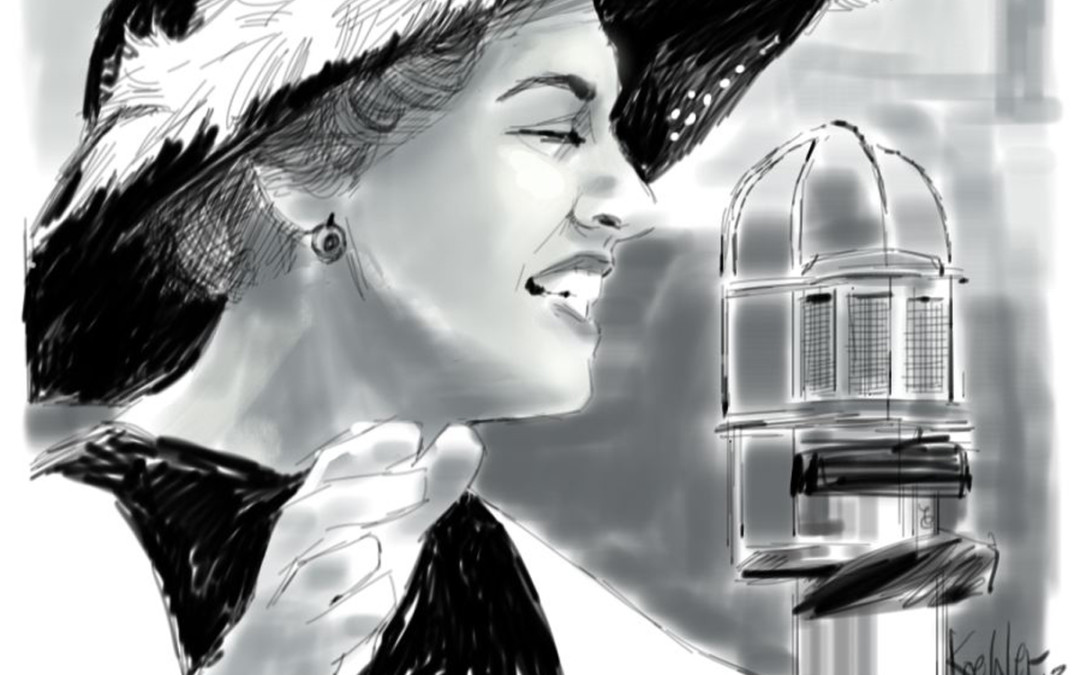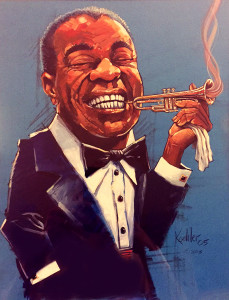Anita O’Day
The film Jazz on a Summer’s Day showcases Anita O’Day singing Sweet Georgia Brown at the 1958 Newport Jazz Festival. I captured this scene for my Movie Still Sketchbook. The film is in color, but I chose black and white because I didn’t want to loose the contrast of what is arguably the best hat ever worn on stage.
I’m not a follower of women’s clothing and accessories and have no idea what such a hat is called, but I know art and this outfit looked like a beautiful pen and ink drawing.
Equally exquisite was her stylized rendition of this classic song. I wish I knew enough about music to describe it. Get on YouTube and take a look. For me, this song, this performance, and this film, epitomizes jazz at its best. Every time I watch this 1960 documentary, I feel I would like to study music theory. Something so full of genius is worth knowing about.
I never heard the term “music theory” until I was 17 years old. A high school friend shared her desire to major in music and was excited that she would get deeper into theory. She gave a sample of what her classes might entail and I was intimidated by the complexity of music at that level.
My best friend was a talented pianist who introduced me to jazz. At first it sounded odd and disordered. I didn’t want to appear unsophisticated, so I pretended to like it. Eventually I was drawn to it, especially when I started to grasp that jazz might be like the expressionist art I liked. I had no idea what was going on inside jazz, but like a Jackson Pollack painting, I sensed it was about layers, textures, tones, and colors.
Since this blog considers art and whimsy, I wonder whether I can think of jazz as whimsical. Jazz presents itself as very serious, heady music. Yet its practitioners look joyful and free when they are in the groove. Anita O’Day looks serious and playful all at once. She poses in her black dress, white gloves, and black hat with its white feather band, with an elegance that shouts sophisticated cool, but with a freedom that touches on whimsical delight. She dips into scat, a human voice reduplication of musical instruments, that seems to have no other purpose than taking joy in the creative luxury of being human.
Louis Armstrong
Louis Armstrong was a major force in the development of American music. I used to only know him as this old guy singing Hello Dolly on Sunday evening variety shows. It was later that I learned what an important musician Mr. Armstrong was. His music was far more more serious than I imagined.
I wanted to capture his joy when I did this illustration. When Louis Armstrong played he exuded joy, maybe whimsy; maybe even whim-wham.
Whim-Wham is the 17th century term from which we get whimsy. It originally meant something quaint or decorative, as in a trinket. I would never consider Louis Armstrong a quaint trinket; he was a musical giant. If that term can be tailored to mean decorated, as in, making something more attractive by adding to it, then it may well fit. If it means decorated as in getting a medal for achievement, then it certainly fits.
Glory
As I grew to appreciate jazz, I learned to consider its genius. I think it might glorious. I consider that every type of people has some unique way of displaying God’s image. I’m delving into speculation, but I wonder what notable God imaging “glories” various nations will display?
What am I talking about?
In the 21st chapter of the Book of Revelation (in the Bible), there is a vivd description of the holy city Jerusalem coming down out of heaven from God. Having the glory of God, it is depicted in great detail as a radiant, bejeweled city. It’s a city without a temple, because “the Lord God the Almighty and the Lamb” (Jesus Christ) are its temple. This city is said to need no sun or moon because the glory of God gives it light.
The passage goes on to say that by this light the nations will walk and the kings of the earth will bring their glory into it (the New Jerusalem). They will bring into it the glory and honor of the nations. Nothing unclean enters it, nor anyone doing detestable or false things, but only those who are written in the Lamb’s book of life. It’s a good place, a safe place, a pure place. No one gets killed there. No abuse, no exploitation, no twisted purpose. No chicanery. No treachery.
If you are at all familiar with this vivid, image-laden book of the Bible, you’ll know that it is not an easy book for modern readers. It’s not at all my purpose here to explain this book or give my opinions on its proper interpretation. My focus for now is the honor and glory of the nations on parade in this safe and good city.
I wonder if Jazz might be part of the honor and glory of a nation.
Art and expression are not trinkets, they are not mere whim-whams. Art is rife with meaning. Creative expression depicts our yearnings, our delights and our hates. Our sorrows and our joys.
Jazz explores, meanders, gets seemingly lost and finally returns. It seems disoriented but then gets put right.
There is a tradition in New Orleans where a jazz band leads a funeral procession, playing a mournful dirge. The sad minor keys groan with the bereaved. After the painful service at the cemetery, the mourners retire elsewhere and the band transitions into uninhibited musical jubilation. I like to think this is meant to announce that death doesn’t get to play the final chord. In fact, death gets kicked off stage.
Wham.



Hello Ed,
I just came home from a fabulous big band jazz concert and saw your blog entry. Of course, I became engaged in it! Within the structured big band arrangements I heard this evening, there are sections mapped out for “open improvisation”. There is one trumpet player who is SO whimsical, that he regularly incorporates musical “quotes” in his jazz solos, to everyone’s delight. These include (but are not limited to) themes from “Peter and the Wolf”, “The Nutcracker”, “Pop Goes the Weasel” and other folk tunes, etc.
As you know, we are created in God’s image. As a musical artist that includes jazz in her repertoire of styles, I see jazz as the perfect kind of music with which to mirror God’s creativity. One is constantly creating music with notes that are not on the page. (Many world-class musicians that can read notes like crazy do not feel comfortable performing jazz.) Jazz is like a musical playground for whimsy. When musicians “trade”, they often take a musical idea they just heard and go nine yards in developing it, then toss a new idea back to the first musician.
Your remark, “Like a Jackson Pollack painting, I sensed it was about layers, textures, tones, and colors” really resonated with me. I have always loved seeing parallels between the arts, and those in turn speak of how God’s creativity has an outlet in inspired humanity.
The New Orleans tradition of funeral music is such a picture of the Gospel, to which you alluded. It is born out of a spirituality the knows God’s saving grace, I’m sure. Thanks for listening to my ramblings….time to edit some photos. I really enjoyed your impressions of Miss O’Day as well…she was one amazing singer!
Linda Gurney
Wow, thanks Linda! I do so appreciate your thoughts. I probably could have recalled more whimsical passages in jazz had I taken time to think about it. I didn’t want to treat jazz the way some people treat modern art writing it off as mere piddling. Improvisation, like coloring outside lines, is threatening to so many people. Your video playing clarinet was fabulous! Let me know when and where your playing, we’ll make it out to see you. Thanks for reading and for your great comments! See you soon.